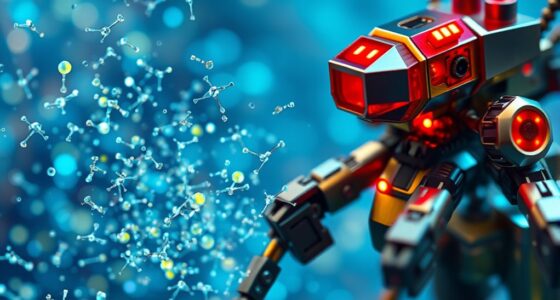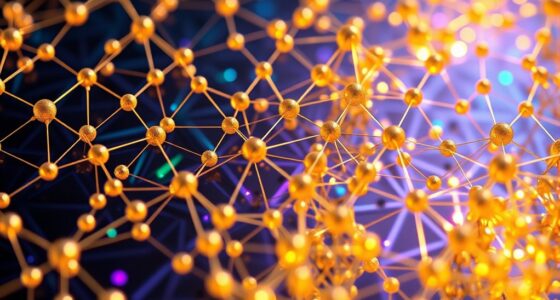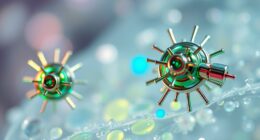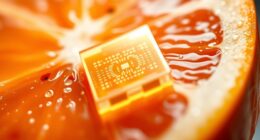Control systems for nanomachines rely on molecular feedback mechanisms inspired by nature, such as enzyme regulation and oscillatory signals. These systems detect molecular cues using specialized sensors, then adjust activity through conformational changes or chemical switching, ensuring precise function despite environmental heterogeneity. Advances like DNA origami, quantum techniques, and bio-inspired strategies enable enhanced control and adaptability. Exploring these methods reveals how natural principles and emerging technologies combine to master control at the molecular level.
Key Takeaways
- Molecular feedback mechanisms, such as enzyme regulation and oscillations, enable nanomachines to adapt and maintain stability within microenvironments.
- Natural systems utilize allosteric sites and protein chaperones to precisely control molecular reactions and folding processes.
- Signal detection at the nanoscale employs sensors like fluorescence and electrochemical devices for real-time feedback.
- Advanced control strategies incorporate DNA origami, chemical switching, and molecular conformations for targeted activation and regulation.
- Future approaches leverage quantum control, AI, and bio-inspired feedback loops for autonomous, high-precision nanomachine regulation.
Understanding the Unique Environment of Nanomachines
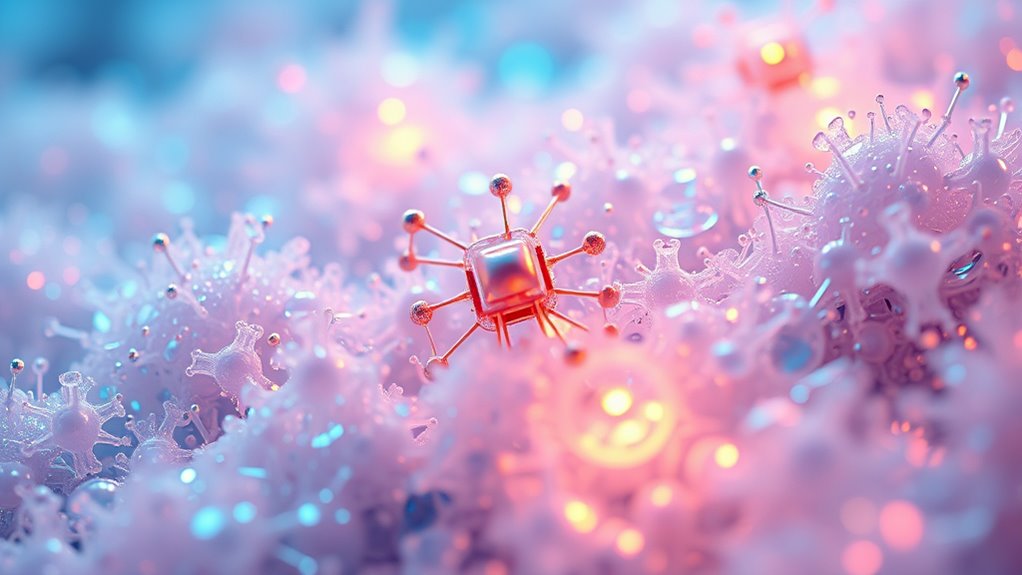
Since nanomachines operate at an extremely small scale, they encounter a vastly different environment compared to macroscopic systems. You must consider the molecular microenvironments surrounding your nanomachines, as these tiny spaces influence their behavior and interactions. Unlike larger systems, nanoscale heterogeneity causes local variations in chemical composition, temperature, and viscosity, which can affect your nanomachine’s performance. These microenvironments are dynamic and often unpredictable, requiring you to adapt your control strategies accordingly. Understanding how molecules behave and interact at this level is vital for designing effective control systems. Recognizing the variety of microenvironments helps in better anticipating challenges and developing precise mechanisms to operate within these intricate molecular landscapes.
Fundamentals of Molecular Feedback Mechanisms
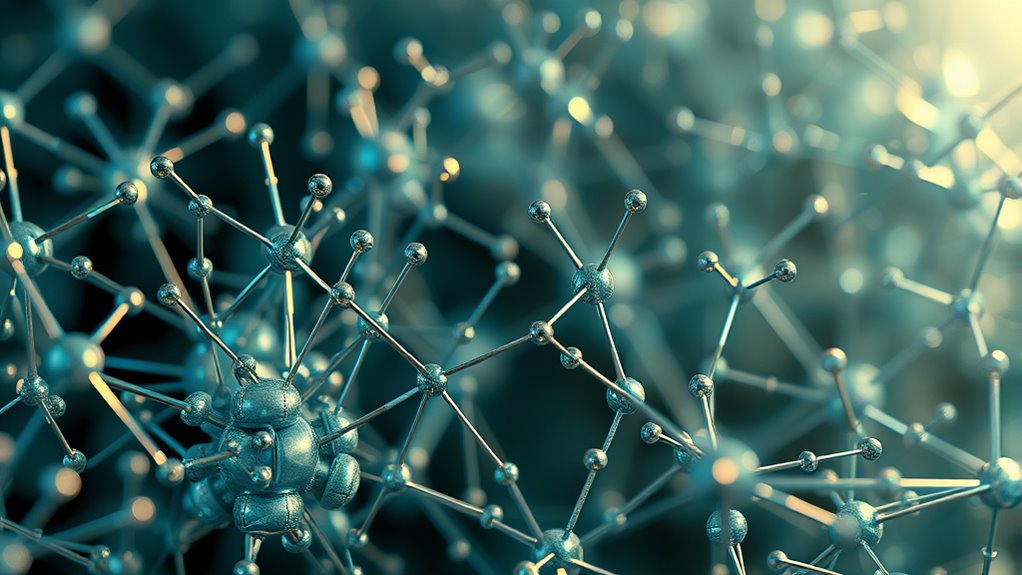
Understanding the complex and dynamic microenvironments where nanomachines operate highlights the importance of precise regulation at the molecular level. Molecular feedback mechanisms, such as enzyme feedback, enable nanomachines to adapt and maintain stability. These mechanisms often involve molecular oscillations, where concentrations of key molecules fluctuate rhythmically, signaling the system to adjust activity accordingly. Enzyme feedback can be positive or negative, amplifying or dampening responses based on target molecule levels. This self-regulation ensures processes stay within ideal ranges, preventing overreaction or failure. Recognizing how molecular oscillations and enzyme feedback work together allows you to grasp how natural systems maintain homeostasis. The essential role of essential oils in supporting health underscores the importance of precise molecular interactions. Mastering these fundamentals is crucial for developing effective control strategies in nanomachines.
Design Challenges in Nanoscale Control Systems

Designing control systems at the nanoscale presents unique challenges because of the limited space, high sensitivity, and the need for precise regulation. Scaling challenges become prominent, as traditional control methods often don’t translate directly to molecular dimensions. Achieving energy efficiency is also critical since nanomachines operate with minimal power, demanding innovative solutions. You must also address signal interference and noise, which are amplified at this scale. The constraints of size and power limit component integration, complicating system robustness. Additionally, fabrication precision becomes essential, as tiny errors can disrupt function. Overcoming these issues requires novel materials, miniaturized sensors, and optimized energy management strategies. These challenges push you to rethink conventional control paradigms, emphasizing the importance of scalability and energy conservation in nanoscale design. Furthermore, integrating AI-driven security systems could enhance robustness against interference and malicious threats, ensuring reliable operation at the molecular level.
Biological Inspiration: Nature’s Molecular Control Strategies
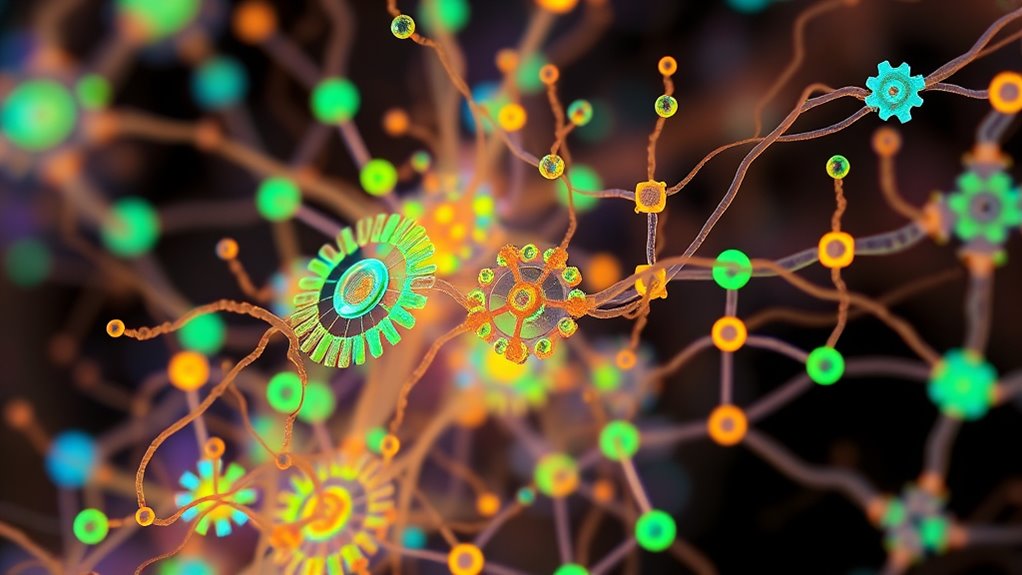
Nature offers an intricate blueprint for controlling molecular functions, demonstrating highly efficient and precise mechanisms that nanomachines can emulate. Protein folding exemplifies this, where molecular chaperones assist proteins in achieving their functional structures, ensuring proper activity. Enzyme regulation showcases how biological systems dynamically control reaction rates, often through feedback mechanisms like allosteric sites. These strategies enable rapid, reversible responses to environmental changes, maintaining cellular stability. By studying these natural control methods, you can develop nanomachines that mimic biological precision. Nature’s molecular control strategies emphasize adaptability and specificity, providing valuable lessons for designing artificial feedback systems. Integrating principles like protein folding pathways and enzyme regulation into nanotechnology allows for more responsive, efficient, and robust control at the molecular level.
Techniques for Detecting and Measuring Molecular Signals
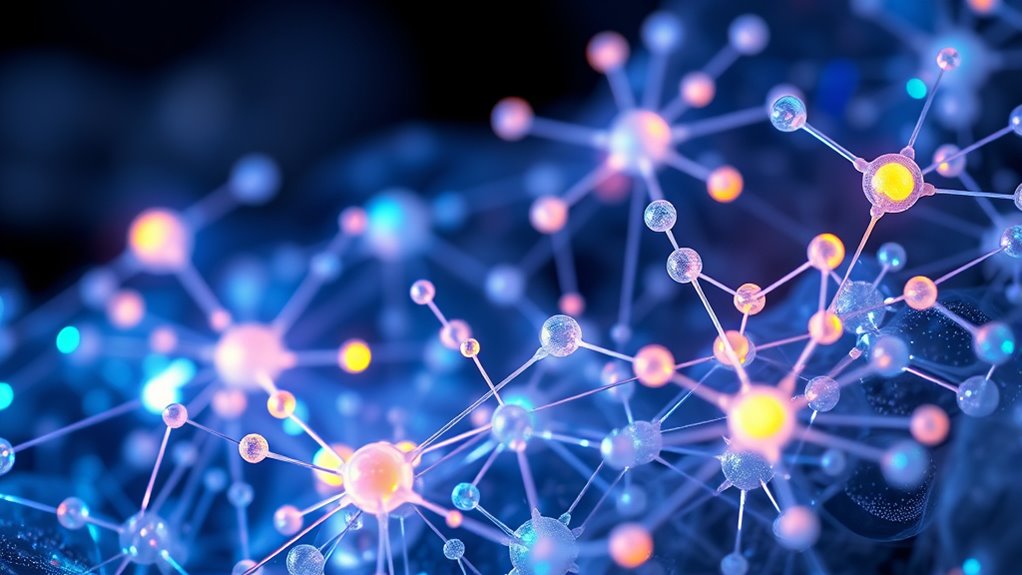
Detecting and measuring molecular signals is essential for controlling nanomachines effectively, as it allows you to monitor their activity and environmental interactions in real-time. You rely on molecular sensors that detect specific signals, converting them into measurable outputs. Signal amplification techniques enhance weak signals, ensuring reliable detection even at low concentrations. These methods improve sensitivity and accuracy, enabling precise control. Techniques include fluorescence-based sensors, electrochemical detection, and nanoscale cantilevers. Advances in signal amplification boost the detection limits, making it possible to sense minute molecular changes. Additionally, optimizing sensor sensitivity plays a crucial role in improving detection capabilities. By integrating these sensors and amplification strategies, you can develop robust feedback mechanisms for nanomachines, facilitating more sophisticated and autonomous control at the molecular level. This foundation is critical for the next steps in nanoscale system development.
Implementing Feedback Loops in Nanoscale Devices

Building effective feedback loops in nanoscale devices begins with integrating molecular sensors that monitor real-time signals from the environment and the nanomachine itself. These nanoscale sensors detect subtle changes, enabling precise control. Molecular timers act as internal clocks, regulating responses based on feedback. By linking sensors and timers, you can create self-regulating systems that adapt dynamically. Here’s a visualization of potential feedback elements:
| Element | Purpose |
|---|---|
| Nanoscale sensors | Detect environmental and internal signals |
| Molecular timers | Manage timing of responses for coordinated actions |
| Feedback controllers | Adjust system operations based on sensor input |
| Actuators | Execute corrective actions within the nanomachine |
This synergy guarantees your nanodevice responds accurately, maintaining stability and functionality at the molecular level. Effective control is essential for the advancement of nanotechnology applications.
Case Studies: Successful Applications of Molecular Control
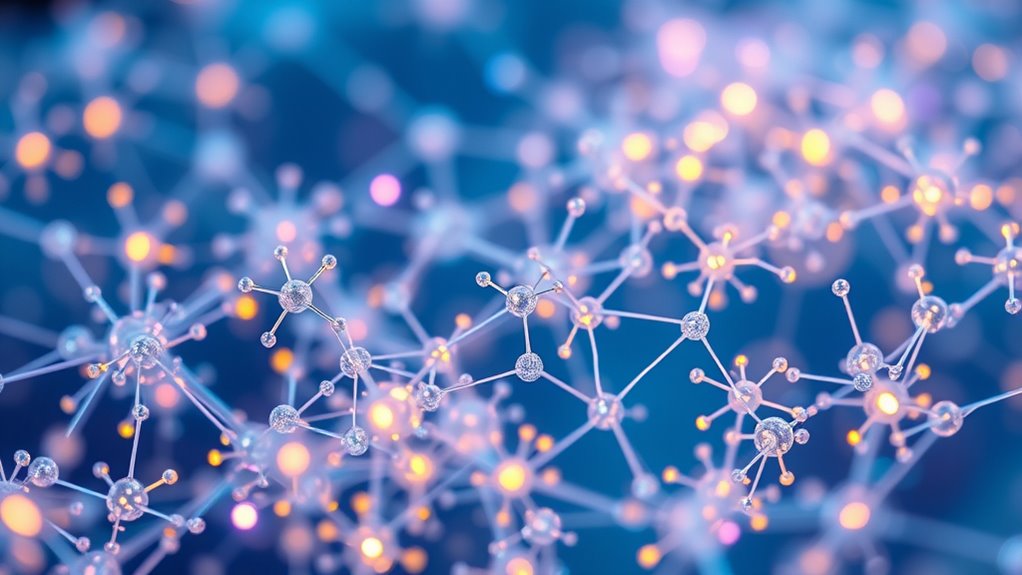
You can see how molecular switches have been used to control nanoscale functions with precision. DNA origami techniques have successfully manipulated structures at the molecular level, demonstrating real-world applications. These case studies highlight the potential of molecular control systems to revolutionize nanotechnology.
Molecular Switches in Action
Molecular switches have demonstrated remarkable success in real-world applications, showcasing their ability to precisely control nanoscale processes. By exploiting changes in molecular conformations through chemical switching, you can trigger specific responses in nanodevices. These switches enable targeted drug delivery, toggle between active and inactive states, and regulate chemical reactions at the molecular level. Their ability to switch conformations rapidly and reliably underpins many advanced technologies. Successful case studies highlight how controlled chemical switching leads to predictable behaviors, improving efficiency and accuracy. The versatility of molecular switches allows them to adapt to diverse environments. As you explore their applications, keep in mind these key ideas:
- Precise control via molecular conformations
- Chemical switching as a trigger mechanism
- Activation and deactivation cycles
- Integration into complex nanodevices
DNA Origami Manipulation
How have scientists achieved precise control over nanoscale structures? By harnessing DNA origami techniques, they design intricate shapes that serve as scaffolds for molecular motors and nanoscale sensors. These structures enable targeted manipulation, allowing you to control how components assemble and move at a molecular level. Researchers have successfully used DNA origami to position molecular motors precisely, driving nanoscale machinery with high accuracy. Additionally, DNA-based devices act as sensors that detect environmental changes, providing real-time feedback vital for nanomachine operation. This manipulation method exemplifies how molecular control enhances functionality, paving the way for advanced nanosystems. Through these case studies, you see how DNA origami offers a powerful platform for achieving precise, programmable control over nanostructures, essential for future nanotechnology applications.
Future Directions and Emerging Technologies in Nanomachine Control

You’re about to explore how quantum control techniques could revolutionize nanomachine precision. AI-driven nanomanipulation promises to make control faster and more adaptable, while bio-inspired regulation systems aim to mimic nature’s efficiency. These emerging technologies will shape the future of nanomachine control in groundbreaking ways. Additionally, advances in sustainable innovation could lead to more environmentally friendly nanomachines that minimize energy consumption and reduce waste.
Quantum Control Techniques
As research advances, quantum control techniques are emerging as promising tools for manipulating nanomachines with unprecedented precision. By leveraging quantum entanglement and superposition states, you can achieve more accurate and rapid control at the molecular level. These methods enable the manipulation of individual particles with minimal disturbance, opening new frontiers in nanotechnology. Quantum control allows you to exploit entangled states for coordinated actions across multiple components, enhancing efficiency. Superposition states provide a way to process multiple control pathways simultaneously, reducing error margins. This approach offers the potential for highly adaptable, scalable control systems, pushing nanomachine capabilities further. As these techniques mature, they could revolutionize how you design and operate nanodevices in fields like medicine, materials science, and quantum computing.
- Quantum entanglement for coordinated control
- Superposition states for parallel processing
- Precision manipulation at the molecular level
- Reduced error through quantum coherence
AI-Driven Nanomanipulation
What if artificial intelligence could revolutionize the way you control nanomachines? AI-driven nanomanipulation leverages advanced algorithms to interpret data from molecular sensors, enabling precise adjustments at the nanoscale. You can deploy AI to optimize the performance of nanoscale actuators, ensuring more accurate and responsive control. This approach allows for real-time decision-making, reducing errors and increasing efficiency in manipulating individual molecules or nanostructures. By integrating machine learning with sensor feedback, you access new possibilities for autonomous operation, adaptable to complex environments. These emerging technologies pave the way for smarter, more reliable nanomachines capable of performing intricate tasks with minimal human intervention, transforming applications across medicine, materials science, and electronics.
Bio-Inspired Regulation Systems
Bio-inspired regulation systems are emerging as a promising avenue to enhance nanomachine control by mimicking the sophisticated mechanisms found in nature. These systems leverage molecular sensors to detect environmental changes and utilize enzymatic feedback to adjust activity dynamically. By replicating biological regulation, you can create nanomachines that adapt more precisely to their surroundings, improving stability and efficiency. This approach enables complex control strategies, such as self-regulation and autonomous response, driven by molecular interactions. You might explore designing feedback loops that incorporate enzymatic reactions, leading to more robust control systems. The integration of bio-inspired elements promises to push nanomachine capabilities closer to natural biological processes, opening new pathways for application and innovation in nanotechnology.
- Molecular sensors for real-time detection
- Enzymatic feedback loops for autonomous regulation
- Adaptive control mimicking biological pathways
- Enhanced stability through bio-inspired mechanisms
Frequently Asked Questions
How Do Quantum Effects Influence Molecular Feedback Mechanisms?
Quantum effects, like entanglement, profoundly impact molecular feedback mechanisms. You’ll see that entanglement effects enable molecules to share information instantaneously, improving coordination. However, quantum decoherence can disrupt this process, causing loss of coherence and reducing feedback precision. So, understanding and managing these effects is essential for designing effective nanomachines, as they determine how reliably molecules communicate and respond at the quantum level.
What Materials Are Optimal for Constructing Nanoscale Control Components?
You should choose materials like DNA origami, carbon nanotubes, or graphene for nanoscale control components, as they offer exceptional strength and flexibility. About 70% of molecular scaffolds and nanoscale sensors use these materials due to their precise programmability and biocompatibility. Their unique properties enable accurate feedback mechanisms, making them ideal for constructing reliable control systems at the molecular level.
Can Artificial Intelligence Improve Molecular Control in Nanomachines?
Artificial intelligence can markedly enhance molecular control in nanomachines through AI integration. By leveraging molecular cognition, AI systems interpret complex molecular signals, enabling precise adjustments at the nanoscale. You can harness AI to optimize feedback loops, improve responsiveness, and predict molecular behavior. This advancement paves the way for smarter, more efficient nanomachines capable of performing intricate tasks with minimal human intervention.
How Do Environmental Factors Affect Molecular Signal Stability?
Environmental variability can markedly impact molecular signal stability, causing fluctuations that lead to signal degradation. You’ll find that changes in temperature, pH, or the presence of other molecules can interfere with signal transmission, making it less reliable. To maintain control, you need to design nanomachines with robust feedback mechanisms that adapt to these environmental factors, ensuring consistent molecular signals despite external disturbances.
What Are the Ethical Considerations of Deploying Nanomachines With Feedback Systems?
Imagine a double-edged sword—deploying nanomachines with feedback systems raises significant ethical concerns. You must consider privacy concerns, as these devices could access sensitive data, and biological safety, ensuring they don’t harm living organisms. Responsibility lies in transparent regulation and rigorous testing, so you safeguard human rights and environmental integrity. Balancing innovation with caution helps prevent unintended consequences, making responsible deployment essential for societal trust and ethical integrity.
Conclusion
Think of nanomachines as tiny sailors steering a vast, unpredictable sea. With molecular feedback, you become the captain, guiding through the currents with precision and adaptability. As you harness nature’s own control strategies, you’ll open new horizons in medicine, technology, and beyond. Embrace this journey, and soon you’ll master the art of guiding these microscopic explorers, turning the unknown into your greatest discovery. The future of nanomachines is waiting for your command.



